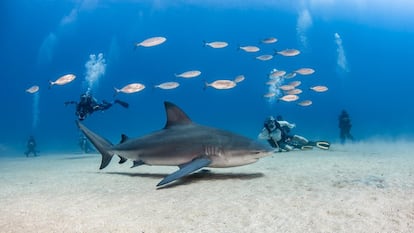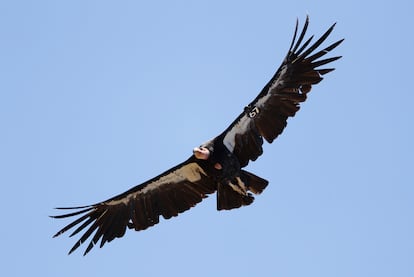The struggle to revive the Sea of Cortez, ‘the world’s aquarium’
Climate change has taken a toll on the diversity of the Gulf of California that dazzled French oceanographer Jacques Cousteau. Several initiatives in the area seek to regenerate its ecosystems

The Gulf of California, also known as the Sea of Cortez, is showing serious signs of deterioration as a result of climate change and the effects of human activities, including the extinction of terrestrial and aquatic species and an increase in temperature in certain areas. “This is something the region has already been experiencing; it is not some future thing. For three decades, it has been increasing in temperature,” warns Octavio Aburto, a professor at the Scripps Institution of Oceanography at the University of California. “There are islets where, from the surface to 40 meters deep, we’re detecting temperatures of 30 degrees Celsius (86 degrees Fahrenheit).”
The “world’s aquarium,” as the French oceanographer Jacques Cousteau called the Gulf of California, no longer exists as we knew it 40 years ago, because, as Aburto says, 80% of it is damaged. For that reason, the ecologist and photographer devoted himself to studying the area for two decades, combining science and research with activism for its conservation.
Although human beings can destroy, “they can also return everything to the way it was,” he says. Cabo Pulmo, a national park in Baja California Sur that is considered a protected natural area and in turn protects a coral reef that Aburto jealously guards alongside the locals, is one example of conservation and recovery. The Mexican scientist has documented that species in that area have recovered by more than 400%; this is an example that is meant to be replicated in other places.
With part of the inheritance that his friend, the oceanographer Walter Munk, left to the University of California, Aburto started a fund to undertake a conservation project with communities in the Gulf of California that have been left behind. In addition to the case of Cabo Pulmo, there are other success stories in the region in which species and ecosystems were rescued; these outcomes were presented last month at the 2023 edition of the Sea of Cortez Forum.
Fish-preserving artificial reefs
“My father was a fisherman and one day he noticed that there were a lot of fish around aquaculture oysters. After years of trial and error, he proved that shells help protect, feed and reproduce fish,” says Masaki Katayama, the president of Japan’s Ocean Construction Company.
Using that finding, Katayama developed Shell Nurse technology, shell-based artificial reefs that serve as a means to increase species biodiversity and fish populations. In Japan, this approach paid off and has been employed in 20,000 different locations. “There is a very good record of improving or increasing fish populations throughout Japan, and because these structures are built by artisanal fishermen, it is an opportunity to earn additional income,” says Koichiro Ishimori, a Japan International Cooperation Agency (JICA) project representative.
In May of this year, that innovation was brought to Mexico. Around 200 artificial reefs were installed in La Paz Bay, in the Gulf of California, as part of a project involving JICA and Ocean Construction. Three tons of shell waste provided by local fishermen were used to make the reefs. The area will be protected for two years so that no one will fish during that time and the ecosystem can recover.
Just three months after the installation of the reefs, there is already evidence of an increase in the density of nine species of fish. “They are fish that already existed, but they decided to come here. There is a greater congregation of stonefish, burritos, yellow snapper, sergeants.... There isn’t even this type of density on Espiritu Santo Island, in the bay itself, which has protection zones,” says Alejandro Robles, the president of NOS Noroeste Sustentable [Sustainable Northwest], which has been studying the Sea of Cortez for over 40 years.
Based on this result, the Government of Baja California Sur decided to finance 200 more reefs to try to recover commercial species. “The idea is to take it to other sites in the Gulf to help recover overfished species, and to give the population more economic options, because the reef can be used for fishing, diving, sport fishing, snorkeling,” says Robles.
The technology will aid the productivity of some 900 fishermen in the Sea of Cortez. Thanks to artificial reefs, a fisherman in Japan can live off the production of 1.7 hectares, while, on average, 50 hectares are not enough for a single fisherman in Mexico.
Robles points out that, in theory, the reefs help to recover the habitat of the different species. But he also warns that, if the causes that led to the species’ depletion do not change, overexploitation will occur again. For that reason, the measure is being implemented alongside a change in the governance and management of ecosystems. “From the outset, the fact that the community is participating in the installation of the [artificial] reef means that it is committed to conserving it,” he points out. “When the population has recovered, commercial fishing can return with very clear rules to avoid overexploitation,” he says. In addition to Robles’s own organization, there are several other organizations in the region that are working with the communities “to develop their capacities for raising awareness, collective agreements, following up on management plans and diversifying activities, with the goal of reducing fishing pressure,” he says.
Rescuing the California condor
Twenty-one years ago, Catalina Porras embarked on a journey that has involved great sacrifice. “We lived in tents for a long time. We still don’t have running water, and we still don’t bathe every day. Every time it snows, we have to shovel it,” she says. “I’ve had to get by on Maruchan [ramen] soups, granola and nuts.” Porras is a scientist dedicated to conserving the endangered California condor, a scavenger bird that measures 1.40 meters (4.6 feet).

Since 2003 she has dedicated her life to the California Condor Reintroduction Program, of which she is the director, along with her colleague Juan Vargas, the project’s field director. This animal became extinct in Mexico in 1970 and there were 22 left in the State of California. The U.S. government decided to capture them to save the species and commissioned the San Diego and Los Angeles zoos to start a program for their breeding and conservation, which in turn was entrusted to Mexican biologists.
Twenty-one years ago, the Sierra de San Pedro Mártir in the Baja California peninsula was chosen as the site to carry out the program and release the birds; the scientists also reside there. Since then, the California condor has been flying in the skies above the Sea of Cortez region. “We survive on love and a commitment to recovering a species that went extinct because of humans,” says Porras. She loves the birds to such an extent that she can distinguish practically every single animal.
From the moment he arrived in the mountains, Juan Vargas knew it would be a lifelong project. The birds lay an egg every two years and live for up to 70 years. “It is very easy to extinguish a species and very difficult to reintegrate it into the wild. But in these 21 years, I have realized that it is possible, that we have achieved it,” says the biologist.
This is not false optimism. Currently there is already a population of 48 condors in the wild; two were born this year and the births of a couple more are expected next year. “The California condor is perhaps the most important conservation project Mexico has,” says Vargas. But the program is at risk due to the difficulties of securing funding.
The scientists are not giving up, and they are hoping that the condor symbolic adoption campaign they recently launched will help.
Tu suscripción se está usando en otro dispositivo
¿Quieres añadir otro usuario a tu suscripción?
Si continúas leyendo en este dispositivo, no se podrá leer en el otro.
FlechaTu suscripción se está usando en otro dispositivo y solo puedes acceder a EL PAÍS desde un dispositivo a la vez.
Si quieres compartir tu cuenta, cambia tu suscripción a la modalidad Premium, así podrás añadir otro usuario. Cada uno accederá con su propia cuenta de email, lo que os permitirá personalizar vuestra experiencia en EL PAÍS.
¿Tienes una suscripción de empresa? Accede aquí para contratar más cuentas.
En el caso de no saber quién está usando tu cuenta, te recomendamos cambiar tu contraseña aquí.
Si decides continuar compartiendo tu cuenta, este mensaje se mostrará en tu dispositivo y en el de la otra persona que está usando tu cuenta de forma indefinida, afectando a tu experiencia de lectura. Puedes consultar aquí los términos y condiciones de la suscripción digital.
More information
Archived In
Últimas noticias
Most viewed
- Sinaloa Cartel war is taking its toll on Los Chapitos
- Oona Chaplin: ‘I told James Cameron that I was living in a treehouse and starting a permaculture project with a friend’
- Reinhard Genzel, Nobel laureate in physics: ‘One-minute videos will never give you the truth’
- Why the price of coffee has skyrocketed: from Brazilian plantations to specialty coffee houses
- Silver prices are going crazy: This is what’s fueling the rally










































